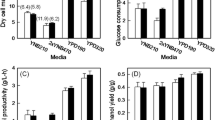Abstract
In this paper, a new spinosad-producing mutant UV-42-13 was obtained by employing rhamnose and sodium propionate resistant selection strategies in series with UV irradiation. Spinosad production of the mutant was 125.3 mg/L, improved 285.5% compared with that of the wild strain (32.5 mg/L).The results of experiment on tolerance of propyl alcohol addition showed that the tolerant ability to precursor was higher. The precursor-resistant ability of the mutant improved through tolerance experiment by adding propyl alcohol, and the spinosad production was greatly increased. The kinetic models for biomass, substrate consumption, and spinosad production of mutant strain and wild strain were studied by conducting batch fermentation in the shaking flask. The result showed that the kinetic models could describe the fermentation process of spinosad producing well.



Similar content being viewed by others
References
Kirst, H., & Michel, K. (1992). American Chemical Society, 214–225.
Sparks, T. C., Crouse, G. D., & Durst, G. (2001). Pest Management Science, 57, 896–905. doi:10.1002/ps.358.
Kirst, H. A., Michel, K. H., & Martin, J. (1991). Tetrahedron Letters, 37, 4839–4842. doi:10.1016/S0040-4039(00)93474-9.
Mertz, F. P., & Yao, R. C. (1990). International Journal of System Bacteriology, 40, 34–39.
Thompson, G. D., Michel, K. H., & Yao, R. C. (1997). Down to Earth, 1, 1–5.
Salgado, V. L. (1998). Pesticide Biochemistry and Physiology, 2, 91–102. doi:10.1006/pest.1998.2332.
Waldron, C., Matsushima, P., & Paul, R. (2001). Chemistry & Biology, 8, 487–499. doi:10.1016/S1074-5521(01)00029-1.
Madduri, K., Waldron, C., & Merlo, D. J. (2001). Journal of Bacteriology, 19, 5632–5638. doi:10.1128/JB.183.19.5632-5638.2001.
Jin, Z., Wu, J.-p., & Zhang, Y. (2006). Journal of Zhejiang University, 7, 366–370. doi:10.1631/jzus.2006.AS0366.
Liu, N., Jin, Z., Luo, J., & Cen, P. (2005). Chinese Journal of Antibiotics, 6, 328–331.
Sanchez, S., & Demain, A. L. (2002). Enzyme and Microbial Technology, 31, 895–906. doi:10.1016/S0141-0229(02)00172-2.
Lin, Y., & Tanaka, S. (2006). Applied Microbiology and Biotechnology, 69, 627–642. doi:10.1007/s00253-005-0229-x.
Passos, F. V., & Fleming, H. P. (1994). Applied and Environmental Microbiology, 7, 2627–2636.
Eglit, K. K. (1997). Microbiology and Molecular Biology Reviews, 3, 646–666.
ABDEI TIF AMRANE (2001). Enzyme and Microbial Technology, 9–10, 827–834.
Luedeking, R., & Piret, E. L. (1959). Journal of Biochemical, Microbiological Biotechnological Engineering, 1, 363–394.
Robinson, J. A. (1985). Advances in Microbial Ecology, 8, 61–l14.
Tang, L., Zhan, G., Sun, W., & Wei, W. (2004). Journal of Hunan University, 3, 23–28.
Author information
Authors and Affiliations
Corresponding author
Rights and permissions
About this article
Cite this article
Liang, Y., Lu, W. & Wen, J. Improvement of Saccharopolyspora spinosa and the Kinetic Analysis for Spinosad Production. Appl Biochem Biotechnol 152, 440–448 (2009). https://doi.org/10.1007/s12010-008-8281-5
Received:
Accepted:
Published:
Issue Date:
DOI: https://doi.org/10.1007/s12010-008-8281-5




